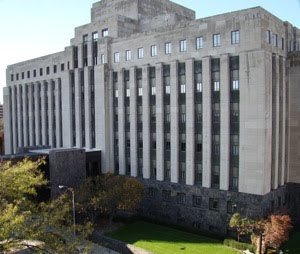From McDonalds’ bathrooms to Art Deco, the Morton Gneiss has a colorful history of use in architecture. I discovered this during my research for Stories in Stone, when I began to develop a list of buildings built with the 3.5-billion-year old, metamorphic rock. I was struck by the Morton’s popularity in the 1930s and specifically in Art Deco or Moderne style projects, where the gneiss was an ideal stone. Several of the buildings later were honored with designation on the National Register of Historic Places.

Adler Planetarium, Chicago, built in 1930, designed by Ernst Grunsfeld, National Register Historic Places
Architectural historians debate the exact dates of Art Deco‘s popularity but basically the period between World War I and II was the heyday. The term comes from the Exposition Internationale des Arts Decoratifs et Industrials Modernes, held at Paris in 1925, and applies to “modern” buildings incorporating exotic motifs, often dramatic, colorful, and playful. Art Deco style design elements also appeared in many non-architectural forms, particularly in machinery and machines.
Oklahoma Natural Gas, now Noble Drilling, 1929, Tulsa, National Register Historic Places
Builders incorporated the Morton for several reasons. It fit the Art Deco aesthetic for unusual colors, particularly as a counterpoint to the light and monochromatic stone, such as Salem Limestone, often used above the base. (By highlighting the dark/light contrast, builders created an unconformity, or missing time gap in the stone record. In the case of the Morton-Salem contact, the missing time gap covers over three billion years, what geologists would refer to as great unconformity. One of the fun aspects of building geology, I think, is to find these artificial unconformities. If readers find others, perhaps they could let me know and I could post a list.)
The Morton’s swirled surface provided a natural counterpoint, as well as complement to the era’s prevailing fascination with machines, geometric patterns, and abstract organic forms. These shapes include Egyptian-stylized form, zig-zags, and chevrons, and are part of define Art Deco. The Morton’s complex texture of light and dark bands typifies gneiss, a type of metamorphic rock formed from great heat and pressure. In the case of the Morton, the major period of metamorphism occurred when its parent rock rammed into the North American continent around 2.7 billion years ago.
Because of the Morton’s color and texture, quarries sold it under trade names such as Oriental, Tapestry, Variegated, and Rainbow Granite. Some people also refer to the Morton as marble. It does have a marbled texture but is not a marble, which is also a metamorphic rock, but one that forms from limestone.
Dark gneiss also helped distinguish a building and set off the base from the surrounding city. Builders may have used the gneiss only at the base because the stone was harder to work, had to be transported long distances, and cost more. In addition, it was more resistant than limestone and sandstone to urban degradation, such as road salt, soot, and noxious vehicle emissions. Each of these factors contributed to builders using the Morton only at the most visible, public ground level.
And, the Morton was simply an interesting stone to look at. It drew people’s attention. It gave the building life; nothing about the Morton feels static or inert. It bestowed complexity; no two panels are the same. As I noted in my book, the dynamic nature of the Morton makes it the most living rock I have seen, quite a claim for what is probably the oldest rock that most people will ever encounter.
A Short List of Art Deco buildings with Morton Gneiss
Adler Planetarium, 1930, Chicago, (NRHS)
David Stott, 1929, Detroit, (NRHS)
Central Bank Trust, 1913, Cincinnati
Watts Building, 1930, Birmingham, (NRHS)
Mariner Tower, 1930, Milwaukee
Pythian Building, 1930, Tulsa
333 N. Michigan Bldg, 1928, Chicago,
Old State Library, 1938, Richmond, VA, (NRHS)
Wisconsin Gas Bldg, 1929, Milwaukee
Cincinnati Telephone Bldg, 1930, Cincinnati
Williamsburg Savings Bank, 1929, Brooklyn
Hartford Gas Co, Hartford, CT
Cincinnati Union Terminal, Cincinnati, 1933
Bankers Life Building, Des Moines, Iowa
Northwestern Bell Telephone (now Qwest), Minneapolis, MN, 1930

Originally the Bankers Life Insurance building, Des Moines, Iowa, built in 1939





